Basic gymnastics shapes are the building blocks of gymnastics. Every skill from rolls, swings and somersaults requires a gymnast to change their body into a number of shapes.
The better you are at performing the basic gymnastics shapes, the better you will become at more advanced gymnastics skills.
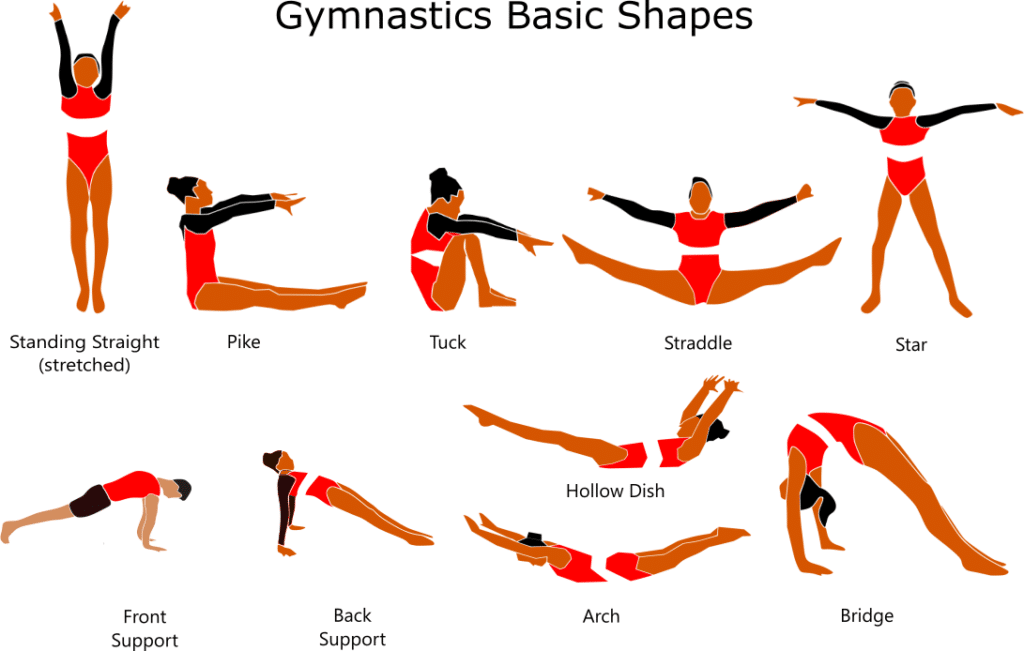
In this article, I will show you the basic shapes and explain how to perform the shapes correctly. These are ideal for practicing at home because you are at lower risk of injury and no equipment is needed although a gymnastics mat could help. Just make sure you have enough space and always warm up beforehand.
All of the gymnastics shapes are static so should be performed with good posture and held for at least 5 seconds without wobble.
Table of Contents
- Tuck Shape
- Pike Shape
- Straddle Shape
- Standing Straight (stretched) Shape
- Star Shape
- Arch Shape
- Hollow Dish Shape
- Support Shapes
- Bridge
- Splits
- Final Thoughts
Disclaimer: Gymnastics carries an inherent level of risk. Information contained in this article does not replace the need for professional coaching in a recognized gymnastics facility.
Tuck Shape
Tuck shapes make the body round and easier to roll and rotate. Practice sitting in a tuck on the floor.
- Bring knees into chest
- Round back
- Knees together
- Arms forward or left-hand holds the left shin and the right-hand holds the right shin (don’t cross hands over)
Tuck shapes are found in skills across all disciplines and apparatus. Simpler moves will include rolling and tuck jumps. More advanced skills include somersaults, flyaway on the bar and Tsukahara on the vault.
Pike Shape
Pike shape is also used to help the body rotate but it is not as easy as the tuck shape. Practice sitting in a pike shape on the floor.
- Legs straight out in front
- Legs together
- Arms also straight out in front
- Back straight and eyes forward
- Toes Pointed
Rolls, jumps and somersaults can be performed in the pike shape but they rotate slightly slower than tuck. Pike shapes are also used in Kip on the bar and versions of the Tsuk vault are also performed in pike.
Straddle Shape
Very similar to the pike shape but the legs are apart. Practice sitting in a straddle shape on the floor.
- Legs out in front but split apart at a 90-degree angle
- Knees point to the ceiling (don’t let them roll inwards)
- Arms above the legs
- Toes pointed
Straddle jumps are common on both floor and beam. Turns will be added to increase the difficulty. Press and cast to handstand start in a straddle shape and the Stalder on bars also passes through a straddle shape.
Standing Straight (stretched) Shape
This is probably the most common gymnastics shape as gymnasts stretch up straight at the start and finish of a lot of skills and routines. Practice standing up and stretching to the ceiling.
- Arms straight and touching ears
- Every muscle stretching including fingertips
- Hips tucked under
- Tight core
- Bottom squeezed
Star Shape
The star shape is used a lot at the beginner and recreational level but not so much at a more advanced level. It’s still worth practicing though. Do this one standing up.
- Legs and arms straight
- Back straight
- Head forward
- Tight core
The star shape is used in jumps on the floor and beam and also as a dismount from the vault such as squat on. The Cartwheel also passes through a star shape. It’s basic stuff but still focus on getting the posture correct.
Arch Shape

Having a tight arch will help you start to master more advanced skills and the ability to change from arch to hollow dish (see below) quickly will create power in a number of skills. Practice arching by lying flat on your tummy.
- Stretch your body to make it as long as possible.
- Lift your arms and feet about 4 to 6 inches from the floor
- Don’t bend at the elbows or knees
- Arms cover ears
- Squeeze your legs together and point your feet
The back handspring passes through a tight arch shape as you are upside down. Swings on the bar also use the quick arch to dish to create an efficient swing.
Hollow Dish Shape
The opposite of the arch is the hollow dish. Practice this lying flat on your back instead of your tummy. The hollow dish is one of the most commonly used gymnastics shapes as its needed in many Tumbling and Vault skills.
- Lift your feet, shoulders and head about 4 to 6 inches from the floor
- Eyes should look at the feet
- Arms can either be back behind the head (harder) or pressed into the hips (easier)
- Legs squeezed together and feet pointed
- Lower back pressed into the floor
Concentrate on the core muscles holding the shape. Avoid arching your back – this is a sign of a weak core. Try sliding your hand under the lower back. If you are unable to get it through then the shape is good. If the hand can fit under the back then it is arched and it needs correcting.
Support Shapes
There are three support positions front, back and side. They are important for skills such as layout through vault, leg circles on pommel horse and swings on parallel bars. The pommel and parallel bars are men’s artistic apparatus so female gymnasts may use them less often.
Front Support Shape
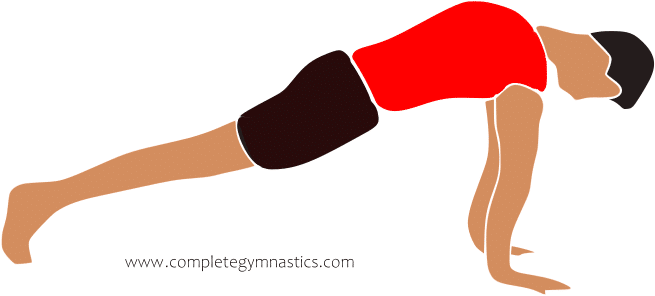
Like a press-up position but without the up-and-down motion.
- Back and hips flat to create a straight slope
- Shoulders over hands (lean forwards slightly)
- Head in a neutral position looking at the floor
- Push shoulder blades apart
Apply a small amount of pressure on the back and shoulders to check stability. If the support collapses it needs to be stronger.
Back Support Shape
The tummy faces the ceiling for the back support shape.
- Hips push upward
- Eyes look at the feet (don’t throw the head back)
- Hands point towards feet
- Legs together
Side Support Shape
Side support is mostly used for leg circles on the pommel. Start in front support and turn towards back support. Stop halfway to create a side support shape.
- Straight arms and legs
- Feet slightly apart to create stability
- Top arm points toward the ceiling
Bridge
Having a bridge with good form is super important for a lot of skills including handstand, walkover and back handspring. The key to a good bridge is shoulder flexibility and being able to have ‘open’ shoulders. If you are new to bridges start by lying on the floor on your back and then pushing up. A good bridge will have:
- Arms and legs straight
- Shoulders pushing backward over the hands
- Eyes looking at hands
- Flat feet (no tip toes)
- Legs together
- Control your body as you lower your back to the floor
Doing a bridge badly can cause injury so take care and seek professional coaching if possible.
Splits
Splits are used a lot in floor routines, the split jump and walkovers also pass through splits in the upsidedown phase. Doing splits badly will affect your form and can cause injury so these pointers are meant only as a guide. A professional coach will always be able to give you personal feedback. Correct splits will have:
- Both legs straight
- Front knee pointing directly upwards
- Back knee pointing directly downwards
- Good posture in the back and head
- Toes pointed
- Upper body facing forward and not twisted to one side
If any of these points are not correct the best thing to do is come up higher from the floor and try to correct it before pushing back down.
Final Thoughts
Keep the focus on improving your basic gymnastics shapes as these will be key to improving your gymnastics in the long term. If you need a mat to practice on at home check out my top 6 recommendations here.
Latest Articles:
- How Much Do Gymnasts Make?
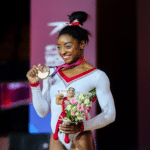 It is very tough to make money as a gymnast. If you are fortunate enough to earn the equivalent of a full-time wage you will… Read more: How Much Do Gymnasts Make?
It is very tough to make money as a gymnast. If you are fortunate enough to earn the equivalent of a full-time wage you will… Read more: How Much Do Gymnasts Make? - Is Gymnastics a Sport? (Debunked)
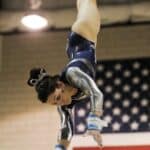 Is Gymnastics a Sport? You bet it is, and we’re about to debunk all the doubts! Dive into our guide where we flip through the… Read more: Is Gymnastics a Sport? (Debunked)
Is Gymnastics a Sport? You bet it is, and we’re about to debunk all the doubts! Dive into our guide where we flip through the… Read more: Is Gymnastics a Sport? (Debunked) - Can You Start Gymnastics at 13?
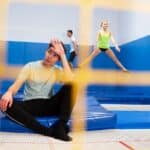 Can you start gymnastics at 13? Absolutely, and here’s the kicker – it’s never too late to flip your way into the world of gymnastics.… Read more: Can You Start Gymnastics at 13?
Can you start gymnastics at 13? Absolutely, and here’s the kicker – it’s never too late to flip your way into the world of gymnastics.… Read more: Can You Start Gymnastics at 13? - Is Gymnastics Harder Than Football? (answered)
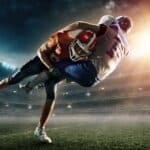 Many people wonder how hard gymnastics really is compared to other sports. In this article, I will analyze different elements of both gymnastics and football… Read more: Is Gymnastics Harder Than Football? (answered)
Many people wonder how hard gymnastics really is compared to other sports. In this article, I will analyze different elements of both gymnastics and football… Read more: Is Gymnastics Harder Than Football? (answered) - Why Is Gymnastics So Expensive?
 Why is gymnastics so expensive? It’s a question that echoes through the halls of gyms and the minds of parents when they see the next… Read more: Why Is Gymnastics So Expensive?
Why is gymnastics so expensive? It’s a question that echoes through the halls of gyms and the minds of parents when they see the next… Read more: Why Is Gymnastics So Expensive? - Is Self-Taught Gymnastics a Good Idea? (answered)
 Over the last twenty years as a gymnastics coach I have seen a huge increase in the number of children (and numerous adults) that have… Read more: Is Self-Taught Gymnastics a Good Idea? (answered)
Over the last twenty years as a gymnastics coach I have seen a huge increase in the number of children (and numerous adults) that have… Read more: Is Self-Taught Gymnastics a Good Idea? (answered)
